Building a successful, sustainable and consistent NHL team is no easy task.
Firstly, there is the construction of the foundation.
All great franchises are based upon a system of intelligent player acquisition and development. In today’s NHL, drafting raw talent is critical to team success, as the continued improvement of particular players ensures prosperity over the long term. If a specific team can consistently draft excellent young individuals of immense potential, consistent and sustainable success becomes much easier to obtain and maintain.
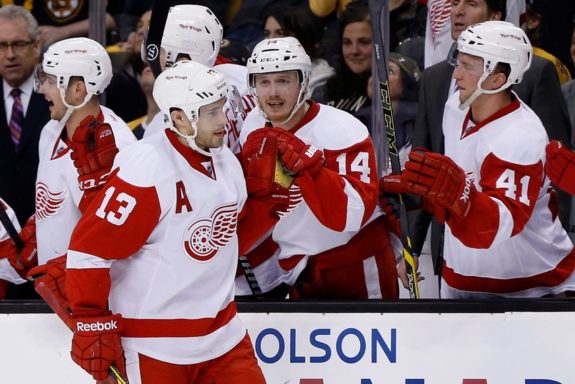
In addition to the importance of drafting and development is the ability to swing sensational trades as well as land valuable players through other means, such as free agency.
Although drafting comprises the core of all NHL teams, calculated trades and crafty signings can represent the difference between a legitimate contender and an annual pretender. If a specific player can be added through trade or signed as a free agent in order to address a glaring organizational need, the ability to draw and land such talent becomes crucial despite its secondary nature.
Throughout the NHL over long periods of time, general managers have been able to assemble teams of great success based on these particular principles. Of recent note are the likes of David Poile, Ken Holland and Doug Wilson — three GM’s who have not only held their positions for much greater than a decade but have enjoyed immense success in the process.
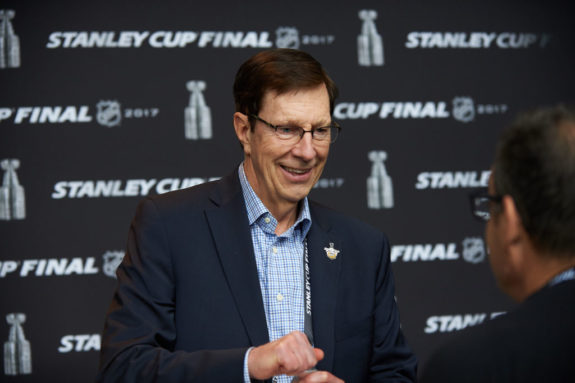
On the other hand, there is also a number of GM’s who, despite their best intentions, have failed to build consistently successful and competitive rosters. In particular are Jim Benning, Marc Bergevin and Joe Sakic. Although each of these three GM’s has enjoyed varying levels of success, all of which remain on the hot seat for numerous reasons but, most notably of all, the inability to build an increasingly competitive team.
Jim Benning: Aimless Administration
Hired: May 21st, 2014
Team Record as GM: 109-110-27 (246 GP); 2-4 in Playoffs
Jim Benning has yet to enjoy considerable success as the GM of the Vancouver Canucks — a situation which has arisen largely from his own doing.
Since Benning took charge of the franchise, the Canucks have reached the playoffs on just one occasion. A mere seven years removed from an appearance in the Stanley Cup Finals, Vancouver is suddenly a listless organization with no true direction or identity. What’s more is that throughout their recent years of ineptitude, Benning has taken very few steps to right his ship and point it in the right direction.
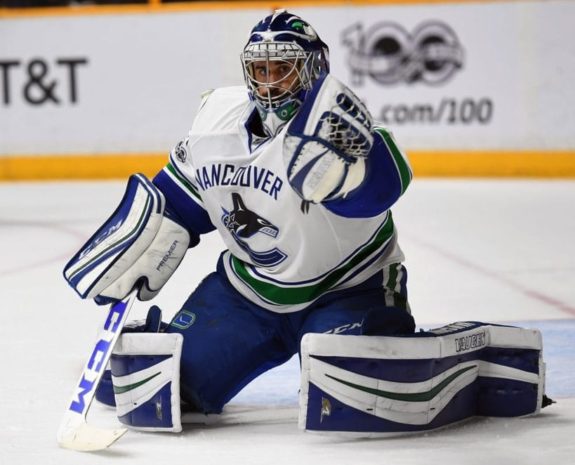
Seemingly unsure of whether to retool or rebuild, Benning has taken an odd approach to managing his team and it is one which will impact the well-being of the franchise in the both the present and the future. Although the Canucks are, quite clearly, no longer fit to legitimately contend, Benning has persisted by signing veteran players to significant contracts — namely the likes of Radim Vrbata, Ryan Miller and Loui Eriksson.
To make matters worse, when these particular players as well as Dan Hamhuis — with the exception of Eriksson — found themselves pending UFAs, Benning failed to pull the trigger on deadline deals which could have added significant young assets to the organization. Speaking of trades, let’s not forget Benning’s deal which sent Eddie Lack to the Carolina Hurricanes. Despite standing on his head for most of the 2014-15 season and proving himself ready for a starting role, Lack was dealt to Carolina for a horrendous return which simply consisted of two late-round draft picks.

Further, there have been Benning’s choices at the annual NHL Entry Draft. As we discussed, drafting and development are essential to the well-being of any franchise in the long term, as those acquired at the Draft will, ideally, comprise the core of the team long into the future. Unfortunately, Benning has — for the most part — struck out despite holding a wealth of high draft picks. Although his 2017 haul has yet to pan out, those chosen by Benning in 2014, 2015, and 2016 appear to be anything but locks for the NHL.
Yes, Brock Boeser, Thatcher Demko and Olli Juolevi all retain immense potential and should develop into successful NHL players, however, virtually none of the other 17 individuals chosen by Benning within those three particular classes have shown promise worth noting. To make matters worse, Benning traded Jared McCann to the Florida Panthers before he was able to fully develop, while the once promising Jake Virtanen has seemingly fallen off of the team’s radar entirely.
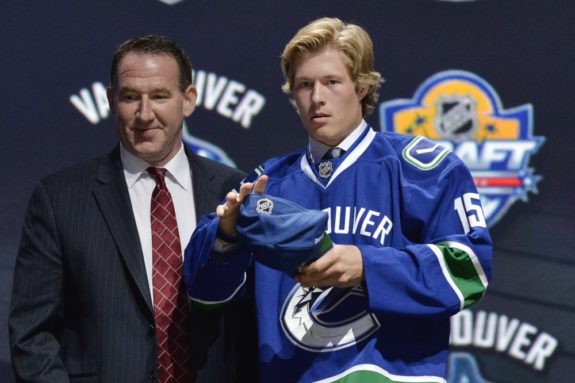
In short, Benning has failed to establish a clear direction for his team. Unable to commit to a full rebuild, Benning’s indecisive nature has positioned the Canucks in a state of flux with no glaring route to redemption. Unless Benning can set a concrete course for the franchise and make the moves necessary for success, Vancouver could very well find itself as a perennial pretender rather than a legitimate contender for the foreseeable future – and, perhaps, in search of a new GM.
Marc Bergevin: Contentious Choices
Hired: May 2nd, 2012
Team Record as GM: 210-128-38 (376 GP); 19-21 in Playoffs
Although Marc Bergevin has, in fact, enjoyed tremendous success during his tenure as GM of the Montreal Canadiens, his time spent crafting the team has held its fair share of formidable challenges and, consequently, has resulted in some questionable decisions.
Despite reaching the playoffs on four of five occasions since taking on the position, Bergevin’s Canadiens have failed to achieve a significant breakthrough on the ice. What’s more is that now, the team appears to be trending in the wrong direction. Although the club reached the Eastern Conference Finals in 2013-14, they have since fallen in both the second and first rounds, while missing the postseason entirely in 2015-16.
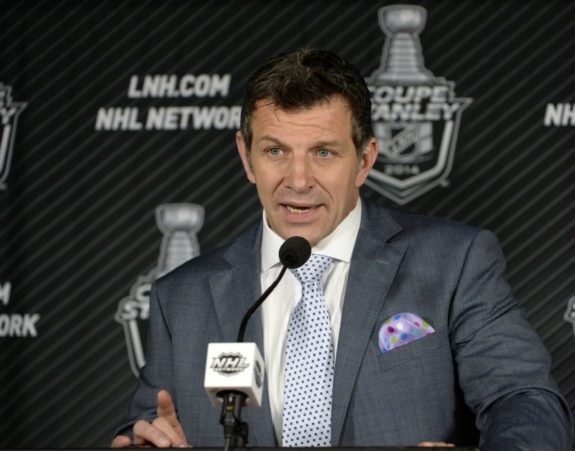
Plagued by an inconsistent offence, thin defence, and a lack of promising young prospects, Bergevin has made a number of decisions of late which has left many questioning his intentions. It all began with the blockbuster trade which sent P.K. Subban to the Nashville Predators in exchange for Shea Weber. Although Bergevin sacrificed both age and flair in order to nab Weber, trading away a fan favourite and player invested in the city of Montreal did not sit particularly well with the great many engaged in the franchise.
More recently, Bergevin, clearly hoping to improve his mediocre offence, traded his best defence prospect — Mikhail Sergachev — to the Tampa Bay Lightning in exchange for Jonathan Drouin. Although the deal added an incredible homegrown talent to the Canadiens’ roster, it also exacerbated an already major area of weakness within the franchise. With an incredibly thin blue line in hand, Bergevin’s decision to deal Sergachev made little sense from an organizational perspective and will surely impact Montreal defensively long into the future.
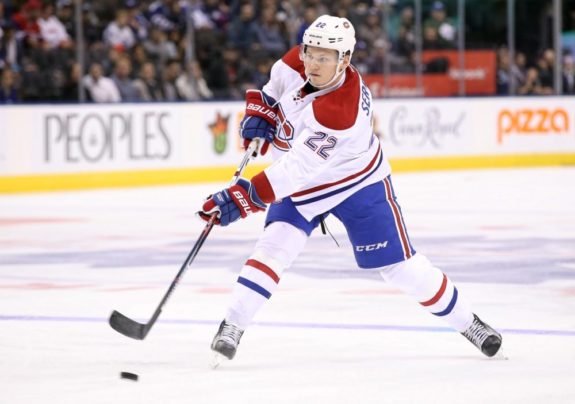
Further, just when it appeared as though Bergevin was done tinkering with his team ahead of the 2017-18 campaign, he traded away yet another young defenceman. As one of the Canadiens’ better young defenders, Nathan Beaulieu was an asset drafted and developed by the team who had begun to truly establish himself at the NHL level of late. Averaging nearly 20:00 of ice time per contest this past season in addition to achieving new career-highs in both goals and points, dealing Beaulieu to the Buffalo Sabres – as well as the loss of Alexei Emelin to Vegas — further degraded the team’s back-end and forced Bergevin to scour the free agent market for veteran replacements.
Through these three trades alone, Bergevin has struggled to establish a distinct direction and identity for his team. With a clear need for offence, Bergevin chose to sacrifice the relative well-being of his defence — and its future — in order to make the changes he deemed necessary. In possession of a team with little depth on offence as well as defence, Bergevin’s willingness to trade his most valuable prospect as well as those in good standing with the team has led to a great deal of confusion.
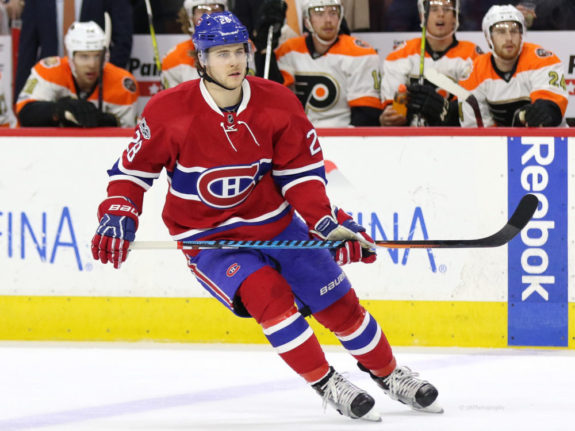
Although the Canadiens will surely be a competitive team in 2017-18, they will now face a greater diversity of problems in comparison to a mere year ago. Lacking considerable depth and skill at virtually every position on the ice outside of the goal, Montreal faces an uncertain and surely difficult future ahead as a result of a number of Bergevin’s questionable decisions. With a veteran offensive-core in place and a number of band-aid solutions on defence, exactly how the Canadiens will be able to maintain their recent level of excellence remains unknown.
Joe Sakic: Paltry Progress
Hired: Sept. 19th, 2014
Team Record as GM: 100-126-20 (246 GP)
To say that the Colorado Avalanche struggled in 2016-17 would be a massive understatement.
Able to garner a mere 48 points during their 82-game season, the Avalanche’s .293% winning percentage was by far their worst in franchise history. Despite possessing a solid core of young players, Colorado simply failed to gel as a team and, as a result, accumulated the NHL’s worst record. To make matters worse, the Avalanche failed to secure the top pick in the 2017 NHL Draft, falling from first to fourth overall as a result of the NHL Draft Lottery.
Unable to reach the playoffs on three consecutive occasions, Colorado, quite obviously, finds itself in the midst of a comprehensive rebuild. With major needs at every position on the ice, the Avalanche will require savvy leadership and definitive direction if they wish to legitimately compete in the near future.
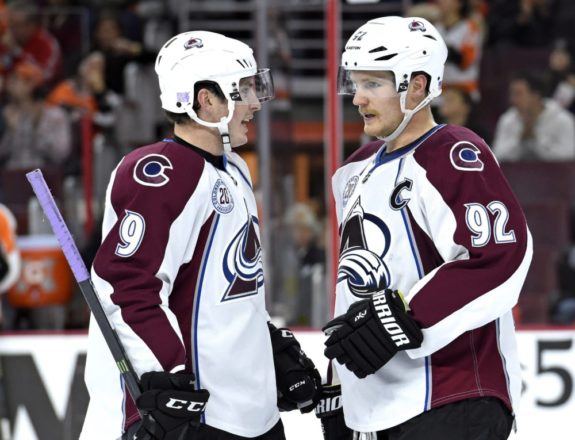
Unfortunately, the current man in charge, Joe Sakic, has already sustained more than his share of criticism – both deserved and undeserved. When he was hired by Colorado, Sakic immediately inherited a roster which was teeming with veteran players and a myriad of others on short-term contracts. Although he was surely pleased to possess the likes of Gabriel Landeskog, Matt Duchene, Nathan MacKinnon and Tyson Barrie, it remained abundantly clear that major changes and additions would be required in order for the Avalanche to thrive in the long-term.
Despite all of the criticism which Sakic has faced, he has, on one hand, done a tremendous job of supplementing his team with excellent young talent. In the past three NHL Drafts alone, Sakic has nabbed all of Mikko Rantanen, A.J. Greer, Tyson Jost, Cale Makar, Conor Timmins, and Nick Henry — six players of varying skill and position who all appear destined for playing time at the NHL level in the near future. With a clear plan to acquire as much elite talent as possible with an emphasis on building from the blue line out, Sakic’s desire to build a highly skilled team is an unmistakable vision.
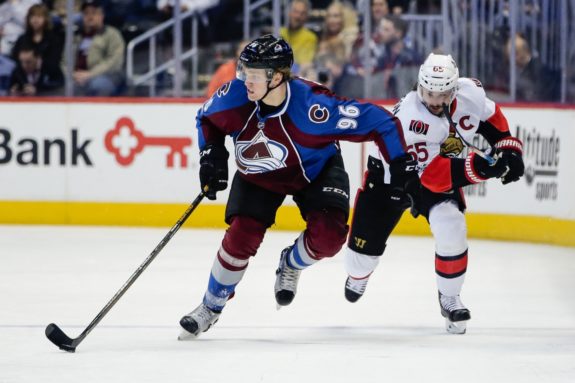
However, on the other hand, despite his immense success and progress at the Draft to date, Sakic has failed in dramatic fashion on the trade front – a major reason behind his perceived instability within the organization. Perhaps the most infamous deal of Sakic’s tenure to date came when he shipped Ryan O’Reilly to the Sabres in exchange for Nikita Zadorov, Mikhail Grigorenko, J.T. Compher and a draft pick. While O’Reilly has become as sensational talent in Buffalo and has earned a seven-year deal, Grigorenko, on the other hand, recently signed in the KHL and Zadorov appears poised to do the same.
Although Compher remains a valuable prospect within Colorado’s organization, his presence alone is not enough to justify the departure of a legitimate top-six forward and one capable of winning face offs with startling regularity.
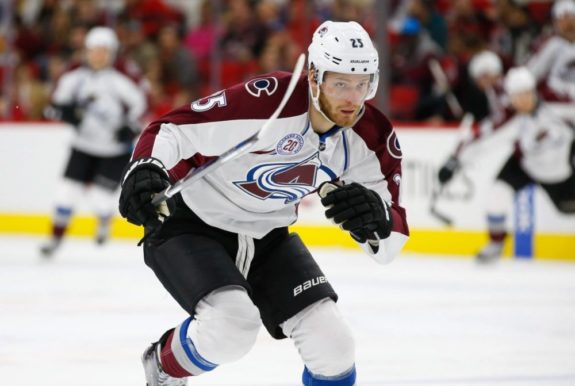
Yet another questionable trade by Sakic occurred late in the 2015-16 season. Despite making it abundantly clear in recent times that he covets young and highly skilled defenders, Sakic traded Kyle Wood, amongst others, to the Arizona Coyotes in a deal which landed the Avalanche Mikkel Boedker. Although he was a relative unknown at the time given his status as a third-round selection, Wood has since developed into a legitimate offensive defenceman who, after a sensational rookie AHL campaign, appears poised to do serious damage at the NHL level.
So, although Sakic has enjoyed success at the annual NHL Draft, his failures on the trade front – as well as inability to improve the team as a whole – have significantly impacted his standing within the organization. While he received a clear vote of confidence from the Avalanche’s President and Governor Josh Kroenke in May, Sakic is clearly on the hot seat and could find himself assuming an alternate role within the organization if Colorado fails to improve in 2017-18.
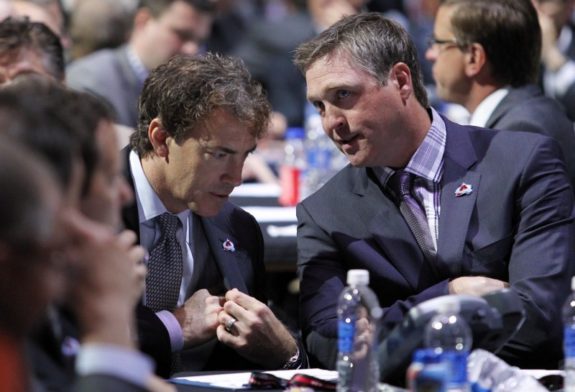
Rebuilding an NHL roster is no easy task, and given his short time as GM to date, Sakic surely deserves a greater, unrestricted opportunity to leave a lasting impression on the team. While he has made his fair share of mistakes, Sakic has also made a number of intelligent decisions which will benefit the organization long into the future. So, although Sakic could easily be fired or replaced given his role as the figurehead of the franchise, it would be unfair to do so until he has been allotted an adequate amount of time to devise, mould, and create a winning and sustainable roster.